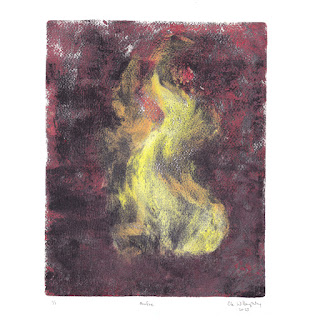I've always been fascinated with May Day traditions, as a May Day baby myself. There are what have been called the "Green Root" (pagan) and "Red Root" (labour) traditions celebrated on the first of May. I've been participating in #FolkloreSunday on Twitter, learning more folklore and using my own artwork to illustrate my own posts. This year seemed like the one to illustrate some of the many "Green Root" traditions of May Day and May Eve like Beltane and Walpurgisnacht.
 |
| Jack-in-the-green, linocut, 8" x 10" by Ele Willoughby, 2023 |
When I participated in #FolkloreWeek last fall, one of the prompts was "tree" and this was the first time I learned about the Jack-Of-The-Green (or Jack O' the Green). I loved the mysterious yet absurd images of walking and dancing men covered in conical wooden or wicker frames covered in foliage, sometimes with a crown of flowers, like a wayward dancing bush leading a procession of characters like the Lord and Lady and a jester, rollicking through the streets. Jack-in-the-green has been part of May Day processions in England since the 1770s. There's a lot of debate about where the tradition came from. Some suspect it arose out of the garlands and floral wreathes worn by milkmaids on May Day, enlarged by the Chimney Sweep guilds (as they celebrated Chimney Sweeper's Day the same day). Others tie it to similar wild men foliage folk figures in continental Europe, pre-Christian fertility figures and the concept of the Green Man. More recent scholarship disputes this connection with the Green Man - but while perhaps not historical the revived 20th century version of the tradition connects the concepts. (You can find more here and here). I have made a Jack-in-the-Green linocut.
 |
| Bonfire, monoprint, 11" x 14" by Ele Willoughby. Hand painted onto a gel plate and printed on water colour paper. |
Beltane ("lucky fire") is the Gaelic May Day festival held on 1 May, or about midway between the spring equinox and summer solstice (in the Northern hemisphere) has traditionally marked the start of summer. It's tied with mythology and was viewed as a time when fairies were strong and offerings were needed to appease the aos sí. It was one of the most important festivals and there are many traditions. I decided to just illustrate one: the lighting of bonfires. People and livestock often had to move through the smoke, or jump over fires or walk between two fires to guard against sickness and witchcraft.
 |
| Walpurgisnacht, monoprint by Ele Willoughby, 7.75" x 9.875", 2023. Hand painted onto a gel plate and printed on water colour paper. |
Bonfires and protection against witchcraft brings us to a May Eve tradition: Walpurgisnacht and Hexennacht (Walpurgis night and Witches' Night as celebrated in Germany). May Eve is the feast day of Saint Walpurga in celebration of her canonization May 1, 870. But folklorists tie it to a more ancient celebration of a moon festival for Walpurga, another name for the Norse goddess Freya of love and beauty who also represented women's magic, sexuality, and independence as well as war and death in battle. She had a magical cloak of falcon feathers and gold necklace, trusty sacred boar friend and a chariot pulled by two cats (cats!). The May Pole can likewise be linked to Yggdrasil, the world tree. Saint Walpurga, amongst other things, apparent fought off witches, so in various European countries, people continue to light bonfires on Saint Walpurga's Eve in order to ward off evil spirits and witches. But in some places people celebrate "Witches' Night", when revelers dress as witches and demons, set off fireworks, dance and play loud music, to drive the witches and winter spirits away. In the Harz mountains the tradition goes back over 1,000 years ago, when people celebrated the arrival of spring making offerings to the god Wodan (or the Norse god Odin).
These are but a few of the many traditions of this time.









No comments:
Post a Comment